Gantavya Bhatt
COBRA: COmBinatorial Retrieval Augmentation for Few-Shot Learning
Dec 23, 2024Abstract:Retrieval augmentation, the practice of retrieving additional data from large auxiliary pools, has emerged as an effective technique for enhancing model performance in the low-data regime, e.g. few-shot learning. Prior approaches have employed only nearest-neighbor based strategies for data selection, which retrieve auxiliary samples with high similarity to instances in the target task. However, these approaches are prone to selecting highly redundant samples, since they fail to incorporate any notion of diversity. In our work, we first demonstrate that data selection strategies used in prior retrieval-augmented few-shot learning settings can be generalized using a class of functions known as Combinatorial Mutual Information (CMI) measures. We then propose COBRA (COmBinatorial Retrieval Augmentation), which employs an alternative CMI measure that considers both diversity and similarity to a target dataset. COBRA consistently outperforms previous retrieval approaches across image classification tasks and few-shot learning techniques when used to retrieve samples from LAION-2B. COBRA introduces negligible computational overhead to the cost of retrieval while providing significant gains in downstream model performance.
How Many Van Goghs Does It Take to Van Gogh? Finding the Imitation Threshold
Oct 19, 2024Abstract:Text-to-image models are trained using large datasets collected by scraping image-text pairs from the internet. These datasets often include private, copyrighted, and licensed material. Training models on such datasets enables them to generate images with such content, which might violate copyright laws and individual privacy. This phenomenon is termed imitation -- generation of images with content that has recognizable similarity to its training images. In this work we study the relationship between a concept's frequency in the training dataset and the ability of a model to imitate it. We seek to determine the point at which a model was trained on enough instances to imitate a concept -- the imitation threshold. We posit this question as a new problem: Finding the Imitation Threshold (FIT) and propose an efficient approach that estimates the imitation threshold without incurring the colossal cost of training multiple models from scratch. We experiment with two domains -- human faces and art styles -- for which we create four datasets, and evaluate three text-to-image models which were trained on two pretraining datasets. Our results reveal that the imitation threshold of these models is in the range of 200-600 images, depending on the domain and the model. The imitation threshold can provide an empirical basis for copyright violation claims and acts as a guiding principle for text-to-image model developers that aim to comply with copyright and privacy laws. We release the code and data at \url{https://github.com/vsahil/MIMETIC-2.git} and the project's website is hosted at \url{https://how-many-van-goghs-does-it-take.github.io}.
Comparing Bad Apples to Good Oranges: Aligning Large Language Models via Joint Preference Optimization
Mar 31, 2024Abstract:A common technique for aligning large language models (LLMs) relies on acquiring human preferences by comparing multiple generations conditioned on a fixed context. This only leverages the pairwise comparisons when the generations are placed in an identical context. However, such conditional rankings often fail to capture the complex and multidimensional aspects of human preferences. In this work, we revisit the traditional paradigm of preference acquisition and propose a new axis that is based on eliciting preferences jointly over the instruction-response pairs. While prior preference optimizations are designed for conditional ranking protocols (e.g., DPO), our proposed preference acquisition protocol introduces DOVE, a new preference optimization objective that upweights the joint probability of the chosen instruction-response pair over the rejected instruction-response pair. Interestingly, we find that the LLM trained with joint instruction-response preference data using DOVE outperforms the LLM trained with DPO by 5.2% and 3.3% win-rate for the summarization and open-ended dialogue datasets, respectively. Our findings reveal that joint preferences over instruction and response pairs can significantly enhance the alignment of LLMs by tapping into a broader spectrum of human preference elicitation. The data and code is available at https://github.com/Hritikbansal/dove.
Deep Submodular Peripteral Networks
Mar 16, 2024



Abstract:Submodular functions, crucial for various applications, often lack practical learning methods for their acquisition. Seemingly unrelated, learning a scaling from oracles offering graded pairwise preferences (GPC) is underexplored, despite a rich history in psychometrics. In this paper, we introduce deep submodular peripteral networks (DSPNs), a novel parametric family of submodular functions, and methods for their training using a contrastive-learning inspired GPC-ready strategy to connect and then tackle both of the above challenges. We introduce newly devised GPC-style "peripteral" loss which leverages numerically graded relationships between pairs of objects (sets in our case). Unlike traditional contrastive learning, our method utilizes graded comparisons, extracting more nuanced information than just binary-outcome comparisons, and contrasts sets of any size (not just two). We also define a novel suite of automatic sampling strategies for training, including active-learning inspired submodular feedback. We demonstrate DSPNs' efficacy in learning submodularity from a costly target submodular function showing superiority in downstream tasks such as experimental design and streaming applications.
An Experimental Design Framework for Label-Efficient Supervised Finetuning of Large Language Models
Jan 12, 2024



Abstract:Supervised finetuning (SFT) on instruction datasets has played a crucial role in achieving the remarkable zero-shot generalization capabilities observed in modern large language models (LLMs). However, the annotation efforts required to produce high quality responses for instructions are becoming prohibitively expensive, especially as the number of tasks spanned by instruction datasets continues to increase. Active learning is effective in identifying useful subsets of samples to annotate from an unlabeled pool, but its high computational cost remains a barrier to its widespread applicability in the context of LLMs. To mitigate the annotation cost of SFT and circumvent the computational bottlenecks of active learning, we propose using experimental design. Experimental design techniques select the most informative samples to label, and typically maximize some notion of uncertainty and/or diversity. In our work, we implement a framework that evaluates several existing and novel experimental design techniques and find that these methods consistently yield significant gains in label efficiency with little computational overhead. On generative tasks, our methods achieve the same generalization performance with only $50\%$ of annotation cost required by random sampling.
Effective Backdoor Mitigation Depends on the Pre-training Objective
Dec 05, 2023



Abstract:Despite the advanced capabilities of contemporary machine learning (ML) models, they remain vulnerable to adversarial and backdoor attacks. This vulnerability is particularly concerning in real-world deployments, where compromised models may exhibit unpredictable behavior in critical scenarios. Such risks are heightened by the prevalent practice of collecting massive, internet-sourced datasets for pre-training multimodal models, as these datasets may harbor backdoors. Various techniques have been proposed to mitigate the effects of backdooring in these models such as CleanCLIP which is the current state-of-the-art approach. In this work, we demonstrate that the efficacy of CleanCLIP in mitigating backdoors is highly dependent on the particular objective used during model pre-training. We observe that stronger pre-training objectives correlate with harder to remove backdoors behaviors. We show this by training multimodal models on two large datasets consisting of 3 million (CC3M) and 6 million (CC6M) datapoints, under various pre-training objectives, followed by poison removal using CleanCLIP. We find that CleanCLIP is ineffective when stronger pre-training objectives are used, even with extensive hyperparameter tuning. Our findings underscore critical considerations for ML practitioners who pre-train models using large-scale web-curated data and are concerned about potential backdoor threats. Notably, our results suggest that simpler pre-training objectives are more amenable to effective backdoor removal. This insight is pivotal for practitioners seeking to balance the trade-offs between using stronger pre-training objectives and security against backdoor attacks.
Accelerating Batch Active Learning Using Continual Learning Techniques
May 10, 2023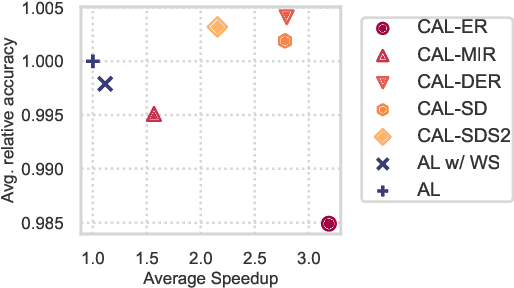



Abstract:A major problem with Active Learning (AL) is high training costs since models are typically retrained from scratch after every query round. We start by demonstrating that standard AL on neural networks with warm starting fails, both to accelerate training and to avoid catastrophic forgetting when using fine-tuning over AL query rounds. We then develop a new class of techniques, circumventing this problem, by biasing further training towards previously labeled sets. We accomplish this by employing existing, and developing novel, replay-based Continual Learning (CL) algorithms that are effective at quickly learning the new without forgetting the old, especially when data comes from an evolving distribution. We call this paradigm Continual Active Learning (CAL). We show CAL achieves significant speedups using a plethora of replay schemes that use model distillation and that select diverse, uncertain points from the history. We conduct experiments across many data domains, including natural language, vision, medical imaging, and computational biology, each with different neural architectures and dataset sizes. CAL consistently provides a 3x reduction in training time, while retaining performance.
High Resolution Point Clouds from mmWave Radar
Jun 18, 2022
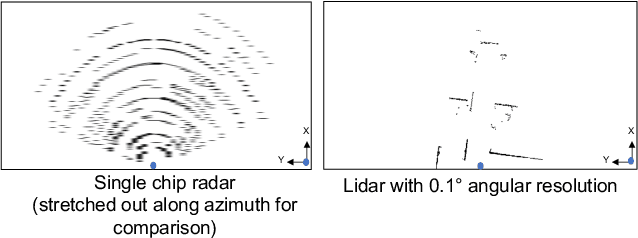
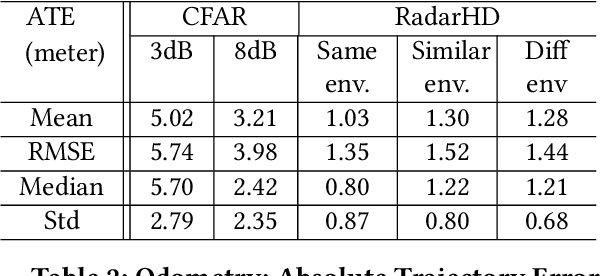

Abstract:This paper explores a machine learning approach for generating high resolution point clouds from a single-chip mmWave radar. Unlike lidar and vision-based systems, mmWave radar can operate in harsh environments and see through occlusions like smoke, fog, and dust. Unfortunately, current mmWave processing techniques offer poor spatial resolution compared to lidar point clouds. This paper presents RadarHD, an end-to-end neural network that constructs lidar-like point clouds from low resolution radar input. Enhancing radar images is challenging due to the presence of specular and spurious reflections. Radar data also doesn't map well to traditional image processing techniques due to the signal's sinc-like spreading pattern. We overcome these challenges by training RadarHD on a large volume of raw I/Q radar data paired with lidar point clouds across diverse indoor settings. Our experiments show the ability to generate rich point clouds even in scenes unobserved during training and in the presence of heavy smoke occlusion. Further, RadarHD's point clouds are high-quality enough to work with existing lidar odometry and mapping workflows.
Matryoshka Representations for Adaptive Deployment
Jun 01, 2022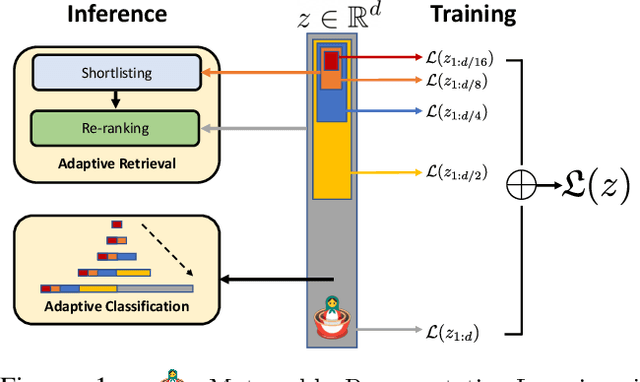
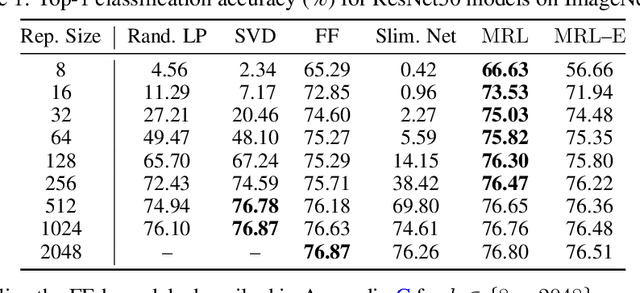
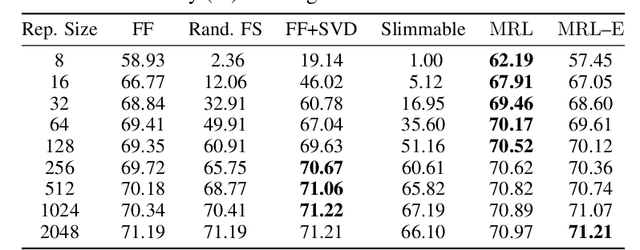
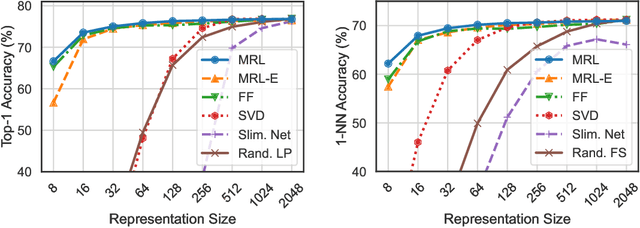
Abstract:Learned representations are a central component in modern ML systems, serving a multitude of downstream tasks. When training such representations, it is often the case that computational and statistical constraints for each downstream task are unknown. In this context rigid, fixed capacity representations can be either over or under-accommodating to the task at hand. This leads us to ask: can we design a flexible representation that can adapt to multiple downstream tasks with varying computational resources? Our main contribution is Matryoshka Representation Learning (MRL) which encodes information at different granularities and allows a single embedding to adapt to the computational constraints of downstream tasks. MRL minimally modifies existing representation learning pipelines and imposes no additional cost during inference and deployment. MRL learns coarse-to-fine representations that are at least as accurate and rich as independently trained low-dimensional representations. The flexibility within the learned Matryoshka Representations offer: (a) up to 14x smaller embedding size for ImageNet-1K classification at the same level of accuracy; (b) up to 14x real-world speed-ups for large-scale retrieval on ImageNet-1K and 4K; and (c) up to 2% accuracy improvements for long-tail few-shot classification, all while being as robust as the original representations. Finally, we show that MRL extends seamlessly to web-scale datasets (ImageNet, JFT) across various modalities -- vision (ViT, ResNet), vision + language (ALIGN) and language (BERT). MRL code and pretrained models are open-sourced at https://github.com/RAIVNLab/MRL.
Systematic Generalization in Neural Networks-based Multivariate Time Series Forecasting Models
Mar 07, 2021



Abstract:Systematic generalization aims to evaluate reasoning about novel combinations from known components, an intrinsic property of human cognition. In this work, we study systematic generalization of NNs in forecasting future time series of dependent variables in a dynamical system, conditioned on past time series of dependent variables, and past and future control variables. We focus on systematic generalization wherein the NN-based forecasting model should perform well on previously unseen combinations or regimes of control variables after being trained on a limited set of the possible regimes. For NNs to depict such out-of-distribution generalization, they should be able to disentangle the various dependencies between control variables and dependent variables. We hypothesize that a modular NN architecture guided by the readily-available knowledge of independence of control variables as a potentially useful inductive bias to this end. Through extensive empirical evaluation on a toy dataset and a simulated electric motor dataset, we show that our proposed modular NN architecture serves as a simple yet highly effective inductive bias that enabling better forecasting of the dependent variables up to large horizons in contrast to standard NNs, and indeed capture the true dependency relations between the dependent and the control variables.
 Add to Chrome
Add to Chrome Add to Firefox
Add to Firefox Add to Edge
Add to Edge